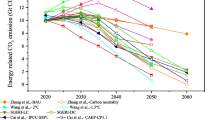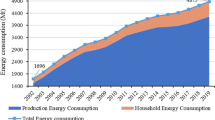Abstract
It is believed that the global CO2 emissions have to begin dropping in the near future to limit the temperature increase within 2 degrees by 2100. So it is of great concern to environmentalists and national decision-makers to know how the global or national CO2 emissions would trend. This paper presented an approach to project the future CO2 emissions from the perspective of optimal economic growth, and applied this model to the cases of China and the United States, whose CO2 emissions together contributed to more than 40% of the global emissions. The projection results under the balanced and optimal economic growth path reveal that the CO2 emissions will peak in 2029 for China and 2024 for the USA owing to their empirically implied pace of energy efficiency improvement. Moreover, some abatement options are analyzed for China, which indicate that 1) putting up the energy price will decrease the emissions at a high cost; 2) enhancing the decline rate of energy intensity can significantly mitigate the emissions with a modest cost; and 3) the energy substitution policy of replacing carbon intensive energies with clean ones has considerable potential to alleviate emissions without compromising the economic development.
Similar content being viewed by others
References
Aiyar S, Dalgaard C, 2009. Accounting for productivity: Is it OK to assume that the world is Cobb-Douglas?. Journal of Macroeconomics, 31(2): 290–303.
Auffhammer M, Carson R T, 2008. Forecasting the path of China’s CO2 emissions using province-level information. Journal of Environmental Economics and Management, 55: 229–247.
Cai W, Wang C, Chen J et al., 2008. Comparison of CO2 emission scenarios and mitigation opportunities in China’s five sectors in 2020. Energy Policy, 36: 1181–1194.
Chen W, 2005. The costs of mitigating carbon emissions in China: Findings from China MARKAL-MACRO modeling. Energy Policy, 33(7): 885–896.
Commoner B, Corr M, Stamler P, 1971. The Closing Circle: Nature, Man, and Technology. New York: Knopf.
Development Research Center of the State Council (DRC), Energy Research Institute of the National Development and Reform Committee (ERI), Institute of Nuclear and New Energy Technology, 2009. 2050 China Energy and CO2 Emissions Report. Beijing: Tsinghua University Press.
Dinda S, 2004. Environmental Kuznets curve hypothesis: A survey. Ecological Economics, 49: 431–455.
Ehrlich P, Holdren J, 1971. Impact of population growth. Science, 171: 1212–1217.
EIA, 2004. International Energy Annual 2002. Washington: EIA Press.
EIA, 2011. International Energy Statistics. [2011-12-10]. http://www.eia.gov/cfapps/ipdbproject/IEDIndex3.cfm
European Commission (EC), 2003. World Energy, Technology and Climate Policy Outlook: WETO 2030. [2004-06-01]. http://194.185.30.69/energysite/pdf/weto_final_report.pdf.
Goldsmith R W, 1951. A perpetual inventory of national wealth. In: NBER Studies in Income and Wealth, National Bureau of Economic Research, New York, 5–61.
Goulder H L, Schneider H S, 1999. Induced technological change and the attractiveness of CO2 abatement policies. Resource and Energy Economics, 21: 211–253.
Harbaugh W, Levinson A, Wilson D, 2002. Reexamining the empirical evidence for an environmental Kuznets curve. Review of Economics and Statistics, 84: 541–551.
IEA, 2004. World Energy Outlook 2004. Paris: OECD/IEA.
IEA, 2006. World Energy Outlook 2006. Paris: OECD Publication Service.
IEA, 2008. World Energy Outlook 2008. Paris: OECD/IEA.
Intergovernmental Panel on Climate Change (IPCC), 2000. Emissions Scenarios. Cambridge: Cambridge University Press.
IPCC, 2007a. Climate Change 2007: The Physical Science Basis. Cambridge: Cambridge University Press.
IPCC, 2007b. Climate Change 2007: Impacts, Adaptation and Vulnerability. Cambridge: Cambridge University Press.
Kaya Y, 1989. Impact of carbon dioxide emission control on GNP growth: Interpretation of proposed scenarios. Paper Presented to the Energy and Industry Subgroup, Response Strategies Working Group, Intergovernmental Panel on Climate Change, Paris.
Kumar U, Jain V K, 2010. Time series models (Grey-Markov, Grey Model with rolling mechanism and singular spectrum analysis) to forecast energy consumption in India. Energy, 35(4): 1709–1716.
Lantz V, Feng Q, 2006. Assessing income, population, and technology impacts on CO2 emissions in Canada: Where’s the EKC?. Ecological Economics, 57(2): 229–238.
Luzzati T, Orsini M, 2009. Investigating the energy-environmental Kuznets curve. Energy, 34(3): 291–300.
Miah M D, Masum F H, Koike M, 2010. Global observation of EKC hypothesis for CO2, SOx and NOx emission: A policy understanding for climate change mitigation in Bangladesh. Energy Policy, 38(8): 4643–4651.
Moon Y S, Sonn Y H, 1996. Productive energy consumption and economic growth: An endogenous growth model and its empirical application. Resource and Energy Economics, 18: 189–200.
National Bureau of Statistics of China (NBSC), 2011. China Statistical Yearbook 2010. Beijing: China Statistical Press.
Nordhaus W D, 2008. A Question of Balance: Weighing the Options on Global Warming Policies. New Haven: Yale University Press.
Park S, Lee Y, 2011. Regional model of EKC for air pollution: Evidence from the Republic of Korea. Energy Policy, 39(10): 5840–5849.
Popp D, 2004. ENTICE: Endogenous technical change in the DICE model of global warming. Journal of Environmental Economics and Management, 48: 742–768.
Ryu H K, 2011. Subjective model selection rules versus passive model selection rules. Economic Modelling, 28: 459–472.
Schmalensee R, Stoker T M, Judson R A, 1998. World carbon dioxide emission: 1950–2050. The Review of Economics and Statistics, 80(1): 85–101.
SEI (Stockholm Environment Institute), 2005. User Guide for LEAP 2005. Boston: Tellus Institute.
Stern N, 2007. The Economics of Climate Change: The Stern Review. New York: Cambridge University Press.
Svirezhev Y, Brovkin V, von Bloh W et al., 1999. Optimisation of reduction of global CO2 emission based on a simple model of the carbon cycle. Environmental Modeling and Assessment, 4(1): 23–33.
Wang J Y, Lin L, 2006. Analysis on labor force participation rate and labor supply in the future in China. Population Journal, (4): 19–24. (in Chinese)
Wang T, Watson J, 2008. Carbon Emission Scenarios for China to 2100. Tyndall Centre Working Paper 121, The Tyndall Centre for Climate Change Research.
Wang T, Watson J, 2010. Scenario analysis of China’s emissions pathways in the 21st century for low carbon transition. Energy Policy, 38: 3537–3546.
Wang Y, 2013. Functional sensitivity of testing the environmental Kuznets curve hypothesis. Resource and Energy Economics, http://dx.doi.org/10.1016/j.reseneeco.2013.01.003.
Weitzman M L, 2007. Subjective expectations and asset-return puzzles. The American Economic Review, 97: 1102–1130.
WRI, 2005. Navigating the Numbers: Greenhouse Gas Data and International Climate Policy. [2013-05-08]. http://www.wri.org/publication/navigating-the-numbers.
Zhang J, Wu G Y, Zhang J P, 2004. The estimation of China’s provincial capital stock: 1952–2000. Economic Research Journal, 10: 35–44. (in Chinese)
Author information
Authors and Affiliations
Corresponding author
Additional information
Foundation: National Basic Research Program of China (973 Program), No.2012CB955804; National Science Foundation of China, No.41201594; CAS Strategic Priority Research Program, No.XDA05150502
Author: Wang Zheng (1954-), Ph.D and Professor, specialized in economics of climate change.
Rights and permissions
About this article
Cite this article
Wang, Z., Zhu, Y. & Peng, Y. Carbon emissions trends with optimal balanced economic growth of China and the USA and some abatement options for China. J. Geogr. Sci. 23, 991–1004 (2013). https://doi.org/10.1007/s11442-013-1058-y
Received:
Accepted:
Published:
Issue Date:
DOI: https://doi.org/10.1007/s11442-013-1058-y




